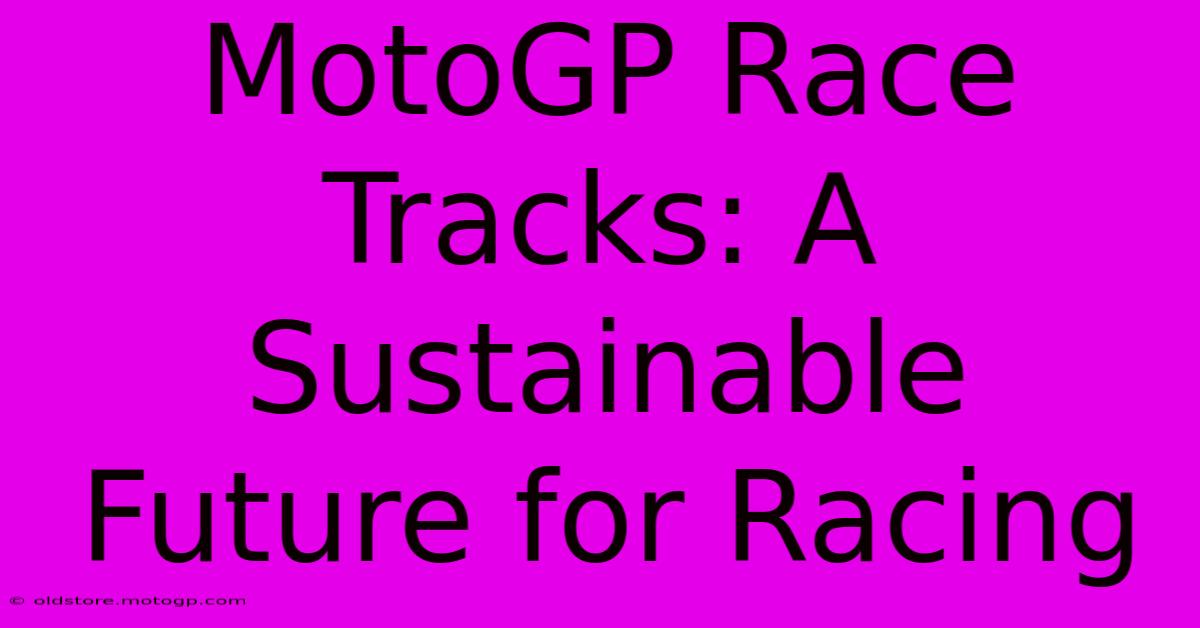MotoGP Race Tracks: A Sustainable Future For Racing

Table of Contents
MotoGP Race Tracks: A Sustainable Future for Racing
The roar of the engines, the smell of burning rubber, the breathtaking speeds – MotoGP is a spectacle of power and precision. But the sport, like many others, faces increasing pressure to minimize its environmental impact. The question is: can MotoGP race tracks pave the way for a sustainable future for racing, and what steps are being taken to make this a reality? The answer is a resounding yes, but it requires a multifaceted approach.
The Challenges of Sustainability in MotoGP
Before diving into solutions, it's crucial to understand the environmental hurdles facing MotoGP. Traditional race tracks often consume significant resources:
- Land Use: Constructing and maintaining tracks requires substantial land, often impacting natural habitats and ecosystems.
- Water Consumption: Track watering, particularly in hot climates, consumes large volumes of water.
- Energy Consumption: Lighting, power for timing systems, and the energy demands of the event itself contribute to a significant carbon footprint.
- Waste Management: The sheer volume of waste generated from events, including tires, packaging, and food waste, presents a substantial disposal challenge.
- Carbon Emissions: The most significant environmental concern revolves around the carbon emissions from the motorcycles themselves, along with transportation of personnel, equipment, and spectators.
Paving the Way for a Greener Future: Sustainable Initiatives
Fortunately, the MotoGP community is actively seeking solutions to address these challenges. Several key initiatives are driving the transition towards sustainability:
1. Sustainable Track Design and Construction
The design and construction of new tracks are incorporating environmentally friendly materials and practices. This includes:
- Use of recycled materials: Incorporating recycled materials in construction reduces the demand for new resources.
- Minimizing land disruption: Implementing designs that minimize habitat disruption and promote biodiversity.
- Green infrastructure: Integrating green spaces, such as vegetation and wetlands, to mitigate environmental impact.
2. Water Management Strategies
Efficient water management is paramount. Strategies include:
- Water recycling and reuse: Implementing systems to recycle and reuse water for track watering, minimizing reliance on fresh water sources.
- Smart irrigation systems: Using technology to optimize watering schedules and reduce water waste.
- Xeriscaping: Utilizing drought-tolerant landscaping to reduce water demand.
3. Renewable Energy Integration
Renewable energy sources are becoming increasingly prevalent:
- Solar power: Installing solar panels to power track facilities and reduce reliance on fossil fuels.
- Wind power: Utilizing wind turbines, where feasible, to generate clean energy.
- Biofuels: Exploring the use of sustainable biofuels for support vehicles and potentially even race motorcycles in the future.
4. Waste Reduction and Management
Comprehensive waste management plans are essential:
- Waste segregation and recycling: Implementing robust recycling programs for all waste streams.
- Composting: Composting organic waste to create valuable fertilizer.
- Waste reduction initiatives: Encouraging spectators and teams to reduce waste generation through conscious choices.
5. Carbon Offset Programs
While reducing emissions is the primary goal, carbon offset programs can help compensate for unavoidable emissions:
- Investing in renewable energy projects: Offsetting carbon emissions by investing in projects that reduce greenhouse gas emissions elsewhere.
- Supporting reforestation efforts: Planting trees to absorb carbon dioxide from the atmosphere.
The Role of Technology in Sustainable Racing
Technological advancements are playing a crucial role in creating greener racing:
- Hybrid motorcycles: The development of hybrid motorcycles offers a significant opportunity to reduce fuel consumption and emissions.
- Data analytics: Using data analytics to optimize track operations and reduce energy consumption.
- Electric motorcycles: The rise of electric motorcycles in lower racing classes offers a glimpse into the potential future of fully electric MotoGP.
The Future is Green: A Collective Effort
Achieving a truly sustainable future for MotoGP requires a collaborative effort from all stakeholders: track owners, racing teams, governing bodies, sponsors, and spectators. By embracing innovative solutions and prioritizing environmental responsibility, the sport can continue to thrill audiences while minimizing its ecological footprint. The journey towards a greener MotoGP is underway, and the future of racing looks increasingly sustainable.

Thank you for visiting our website wich cover about MotoGP Race Tracks: A Sustainable Future For Racing. We hope the information provided has been useful to you. Feel free to contact us if you have any questions or need further assistance. See you next time and dont miss to bookmark.
Featured Posts
-
Cota Parking Season Parking Pass Information
Feb 25, 2025
-
Moto Gp Today Crash And Controversy
Feb 25, 2025
-
Preventing The Next Moto Gp Accident What Needs To Change
Feb 25, 2025
-
The Ultimate Vip Experience Club Si Austin F1
Feb 25, 2025
-
Surprise Pole Predictions Austin F1 Qualifying
Feb 25, 2025
